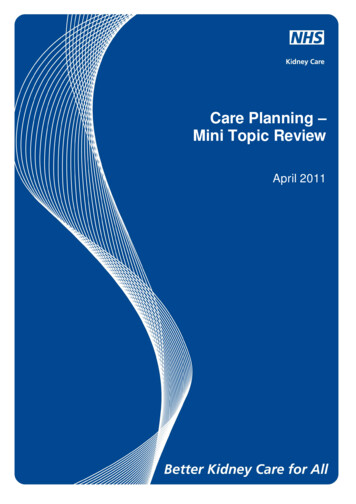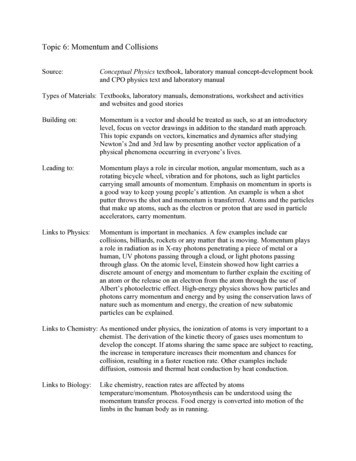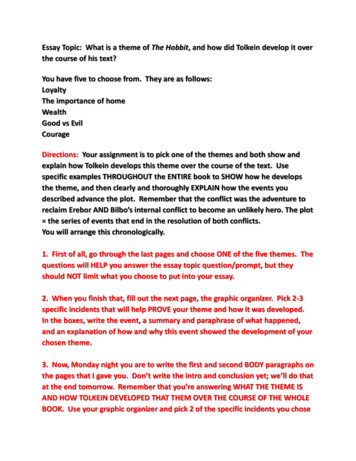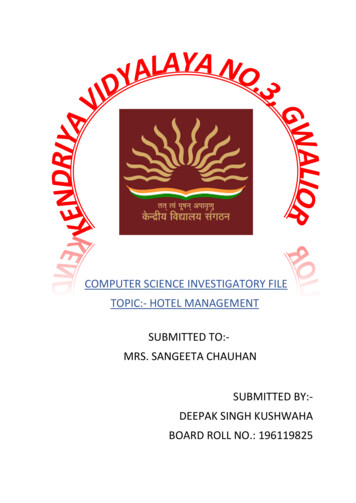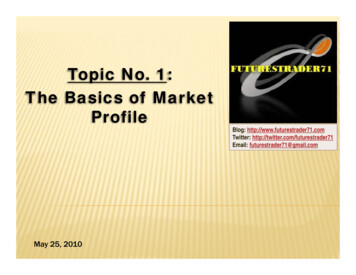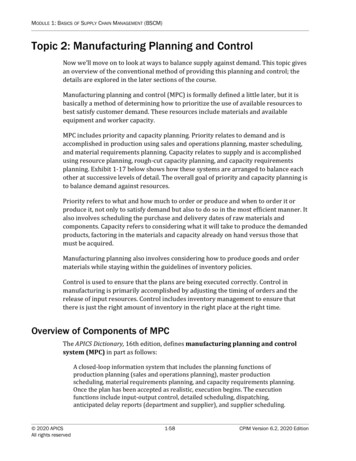
Transcription
MODULE 1: BASICS OF SUPPLY CHAIN MANAGEMENT (BSCM)Topic 2: Manufacturing Planning and ControlNow we’ll move on to look at ways to balance supply against demand. This topic givesan overview of the conventional method of providing this planning and control; thedetails are explored in the later sections of the course.Manufacturing planning and control (MPC) is formally defined a little later, but it isbasically a method of determining how to prioritize the use of available resources tobest satisfy customer demand. These resources include materials and availableequipment and worker capacity.MPC includes priority and capacity planning. Priority relates to demand and isaccomplished in production using sales and operations planning, master scheduling,and material requirements planning. Capacity relates to supply and is accomplishedusing resource planning, rough-cut capacity planning, and capacity requirementsplanning. Exhibit 1-17 below shows how these systems are arranged to balance eachother at successive levels of detail. The overall goal of priority and capacity planning isto balance demand against resources.Priority refers to what and how much to order or produce and when to order it orproduce it, not only to satisfy demand but also to do so in the most efficient manner. Italso involves scheduling the purchase and delivery dates of raw materials andcomponents. Capacity refers to considering what it will take to produce the demandedproducts, factoring in the materials and capacity already on hand versus those thatmust be acquired.Manufacturing planning also involves considering how to produce goods and ordermaterials while staying within the guidelines of inventory policies.Control is used to ensure that the plans are being executed correctly. Control inmanufacturing is primarily accomplished by adjusting the timing of orders and therelease of input resources. Control includes inventory management to ensure thatthere is just the right amount of inventory in the right place at the right time.Overview of Components of MPCThe APICS Dictionary, 16th edition, defines manufacturing planning and controlsystem (MPC) in part as follows:A closed-loop information system that includes the planning functions ofproduction planning (sales and operations planning), master productionscheduling, material requirements planning, and capacity requirements planning.Once the plan has been accepted as realistic, execution begins. The executionfunctions include input-output control, detailed scheduling, dispatching,anticipated delay reports (department and supplier), and supplier scheduling. 2020 APICSAll rights reserved1-58CPIM Version 6.2, 2020 Edition
SECTION B: MANUFACTURING DESIGN, PLANNING, AND CONTROLClosed-loop means that capacity constraints are considered when planning andcontrolling manufacturing. Closed-loop material requirements planning is defined alittle later. Exhibit 1-17 shows how the components of MPC discussed in the definitioninterrelate.Exhibit 1-17: Manufacturing Planning and ControlAs one moves from the top of the diagram to the bottom, the level of detail increaseswhile the time horizon shrinks.Let’s walk through this diagram and informally define the components. We will savethe formal definitions for the sections in which these components are discussed ingreater detail. Note that strategic planning is shown at the top. This includes businessplanning and is usually considered to be an input to manufacturing planning andcontrol rather than a part of it. Strategy and the manufacturing business plan (whichis a subset of the strategy) set the direction and goals that manufacturing must meet.The graphic conveys that the organization’s plans face pressure from two directions:the demand side and the supply side. The demand-side pressures are motivated toensure that all demand is satisfied to maximize revenue; the supply-side pressures are 2020 APICSAll rights reserved1-59CPIM Version 6.2, 2020 Edition
MODULE 1: BASICS OF SUPPLY CHAIN MANAGEMENT (BSCM)a push back based on capacity or what is feasible to do given available or plannedresources. The center is priority planning, where decisions are made on how to meetdemand to the extent possible.The demand-side activities on the left of the exhibit provide key inputs tomanufacturing planning and control in the form of quantities required. Thesequantities come from forecasting, demand management, and distributionrequirements planning (DRP) (addressed in detail in Section M, Topic 2).Forecasts of demand can be made directly, or forecasts or actual orders can beprovided from downstream customers, for example, orders from distributioncenters (DCs) through DRP. Note that these orders are shown being provided atthe master schedule level but any orders already in the system at earlier planningphases will also be accounted for at the higher S&OP or production plan level (thegraphic shows this as an arrow up to demand planning and an arrow from thereto S&OP). Demand management is used to prioritize this demand whennecessary. Demand management also estimates the impact of marketing activitieson demand. Consensus opinions of demand from the supply side of theorganization are provided to multiple levels of planning. At the strategic planninglevel, this is in the form of totals such as total projected sales revenues. Using thisand other information, the organization sets its strategic sales goals and forms amanufacturing business plan.At the next level down, manufacturing planning and control meets the supply sideof the organization. Demand information in the aggregate (product families ortotal units) is used to perform master planning. The APICS Dictionary, 16thedition, defines master planning asa group of business processes that includes the following activities: demandmanagement (which includes forecasting and order servicing); production andresource planning; and master scheduling (which includes the master scheduleand the rough-cut capacity plan).Master planning begins with sales and operations planning, which is anexecutive-level decision-making process where the supply, demand, and financialsides of the organization agree on a consensus plan for satisfying demand in afeasible and profitable manner. The result is a production plan: a consensus set ofnumbers that the supply side of the organization commits to produce and thedemand side (marketing and sales) agrees to set as their sales goals. Resourceplanning occurs at this point as well, which is the first of several capacitymanagement activities that grow more detailed and shorter in time horizon fromthis first long-term, big-picture capacity check. At this level, capacity managementtakes the form of planning for long-term capacity needs such as adding orreducing plants, equipment, and staffing. 2020 APICSAll rights reserved1-60CPIM Version 6.2, 2020 Edition
SECTION B: MANUFACTURING DESIGN, PLANNING, AND CONTROLThe next level of master planning is master scheduling. This is planning over ashorter time horizon, and the demand information provided is now at the detaillevel for individual units. (These could be raw materials in a make-to-orderenvironment, components in an assemble-to-order environment, or finishedgoods in a make-to-stock environment.) The second level of capacity planning,rough-cut capacity planning, takes place at this point. This is a check to see ifbottleneck work centers and other key resources will have sufficient capacity.Once any adjustments are made, the output of master scheduling is a masterproduction schedule for each product. The schedule indicates what will be madein each time period of the planning horizon.Continuing down, now we begin the detailed planning and scheduling needed tomeet the master production schedule. This involves material requirementsplanning (MRP), which uses bills of material and other basic inputs (to bediscussed later) to calculate all of the raw materials and components that need tobe used from inventory or purchased. MRP also calculates when to purchase orrelease these items so they will arrive on time. This is a highly detailed activity,and the third level of capacity planning, capacity requirements planning, occurs atthis point. This capacity check looks at all resource capacities, not justbottlenecks. The result of this process is a finalized material requirements plan.The bottom level is where planning ends and execution takes over. The materialrequirements plan results in purchasing wherever resources are not sufficient.Purchasing includes sourcing, ordering, and scheduling deliveries. The parts ofthe material requirements plan that will be produced in-house become inputs toproduction activity control (PAC). PAC is used to regulate the flow of workthrough the production processes, which will involve scheduling. Scheduling canbe used to adjust when certain orders are released for production or finalassembly. This allows shop floor management to fine-tune production efficiency,accommodate expedited orders, or compensate for delays, material shortages, orquality issues. Capacity control is the fourth level of capacity management and isused here to control work center capacity.Some key points about this system are as follows: 2020 APICSAll rights reservedPlanning occurs from the top down, meaning that every planning and controlactivity links back to the manufacturing business plan (the exhibit includesthis as part of strategy) and ultimately to strategic goals.It is a closed-loop system, meaning that it incorporates feedback in the form ofreports or action alerts so that plans can be adjusted in the long, medium, andshort terms and execution can be adjusted based on events before or duringproduction.1-61CPIM Version 6.2, 2020 Edition
MODULE 1: BASICS OF SUPPLY CHAIN MANAGEMENT (BSCM) It is an iterative system, meaning that plans start out in a rough state and arerefined by revisiting them multiple times as they become more and moredetailed and shorter and shorter in time horizon.The system balances tradeoffs to find the optimum result for all stakeholders,including the supply side, the demand side, and finance. This cross-functionalcollaboration takes place not only during sales and operations planning butalso during master scheduling and later during production activity control aspriorities can be shifted to account for new information. Advanced planningand scheduling systems can also be used to coordinate the activities ofmultiple plants or multiple supply chain partners. The Dictionary definesadvanced planning and scheduling (APS) as follows:Techniques that deal with analysis and planning of logistics andmanufacturing during short, intermediate, and long-term time periods. APSdescribes any computer program that uses advanced mathematicalalgorithms or logic to perform optimization or simulation on finite capacityscheduling, sourcing, capital planning, resource planning, forecasting,demand management, and others.These techniques simultaneously consider a range of constraints andbusiness rules to provide real-time planning and scheduling, decisionsupport, available-to-promise, and capable-to-promise capabilities. APSoften generates and evaluates multiple scenarios. Management then selectsone scenario to use as the “official plan.” The five main components of APSsystems are (1) demand planning, (2) production planning, (3) productionscheduling, (4) distribution planning, and (5) transportation planning. The supply side is concerned with capacity in terms of feasibility andavailability, while the demand side is concerned with prioritizing the timingand order of work, especially to satisfy demand from the most importantcustomers or those with the most acute needs.How MPC Components Fit into the Business HierarchyExhibit 1-18 interrelates the manufacturing planning and control componentsjust introduced to the manufacturing environments and the strategic, tactical,and operational planning elements of the business hierarchy introduced earlier. 2020 APICSAll rights reserved1-62CPIM Version 6.2, 2020 Edition
SECTION B: MANUFACTURING DESIGN, PLANNING, AND CONTROLExhibit 1-18: MPC Components and Business HierarchyLevelHorizonFrequencyDetail LevelProcessValidationStrategic 2 yearsAnnuallySummaryBusiness planningFinancingTactical 18 monthsMonthlyAggregateS&OPResourceplanning 3 monthsWeekly MTS End item ATO Subassembly MTO RawMaster schedulingRCCPmaterialsOperational 10 weeksDailyIntenseMRPCRP 6 weeksShiftMost intense Work orders Purchase ordersSchedulingThis exhibit shows how business planning horizons shrink as planning becomes moredetailed and intense. Note that the horizons shown are for illustrative purposes andcould differ depending on the industry. Note also how the level of detail at the tacticallevel will depend on the manufacturing environment. For the “Validation” column,note the addition of financing as a validation step, which would be where the financialmerits of the overall strategy are assessed and approved or rejected and how tofinance the investment is determined. Note that the lowest operational levelencompasses production activity control as well as purchasing.Evolution to Current Use of Enterprise Resources Planning for MPCIt is important to understand how conventional manufacturing planning and controlsystems have evolved over the past several decades, because this history provides agreat deal of information on the current strengths and weaknesses of these systems.Manufacturing planning and control is extraordinarily complex and involves balancingtradeoffs and constraints in multiple areas, so manufacturers above a certain sizegenerally require computer systems to do these calculations. For most organizations,this means having an enterprise resources planning (ERP) system or an equivalent.The APICS Dictionary, 16th edition, defines enterprise resources planning (ERP) asfollows:Framework for organizing, defining, and standardizing the business pro
2020 APICS 1-58 CPIM Version 6.2, 2020 Edition All rights reserved Topic 2: Manufacturing Planning and Control Now we’ll move on to look at ways to balance supply against demand. This topic gives an overview of the conventional method of providing this planning and control; the details are explored in the later sections of the course.
